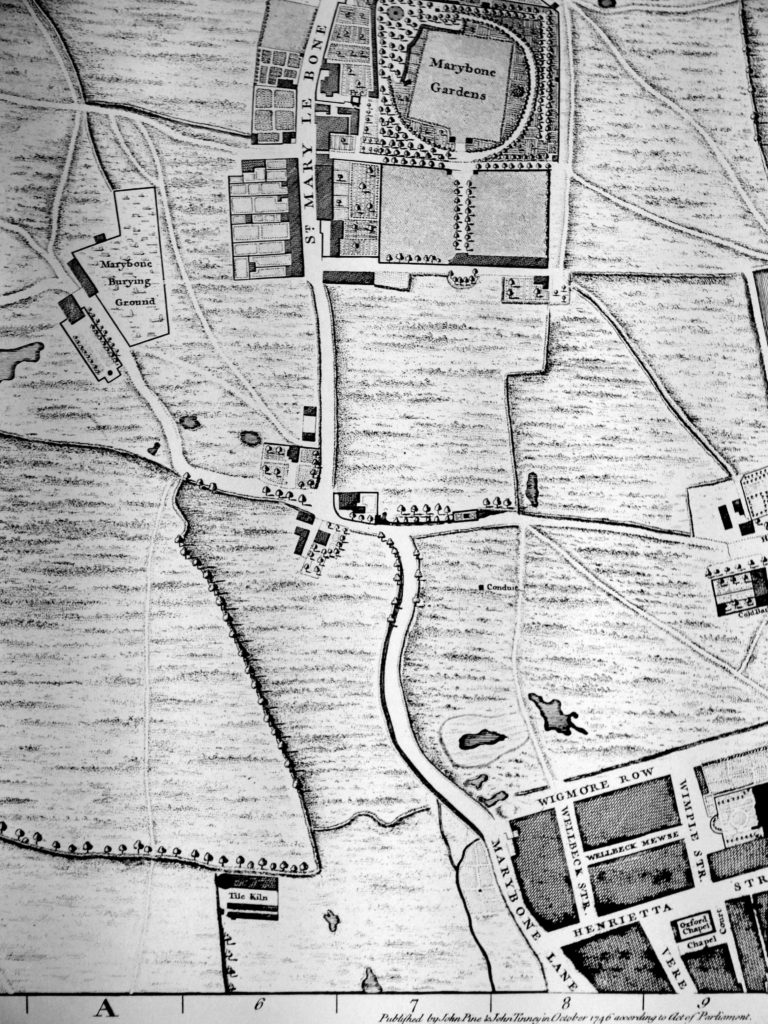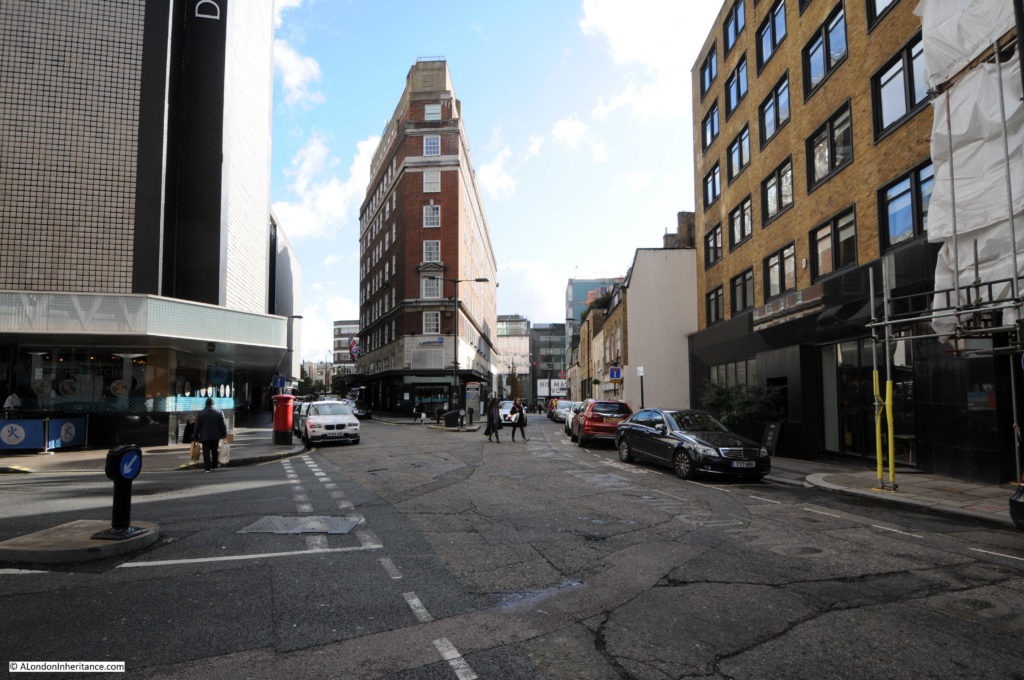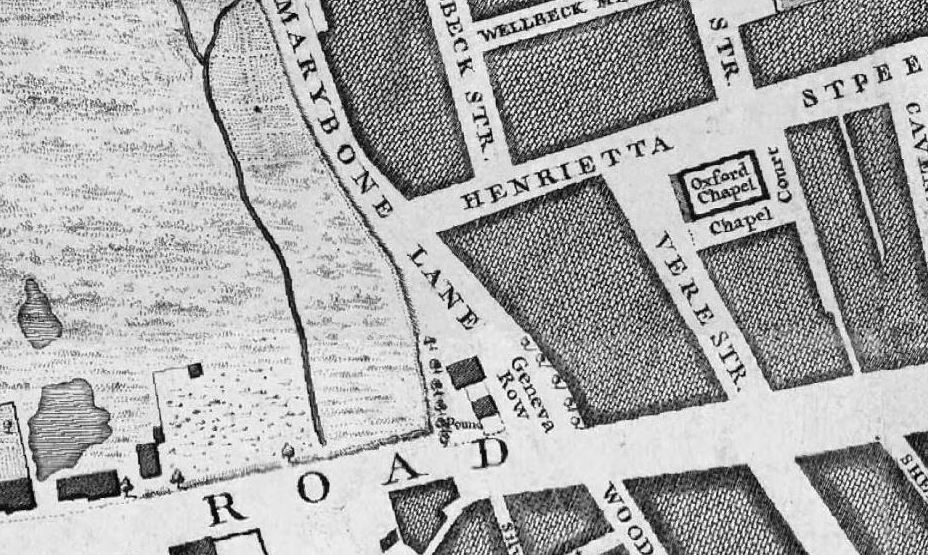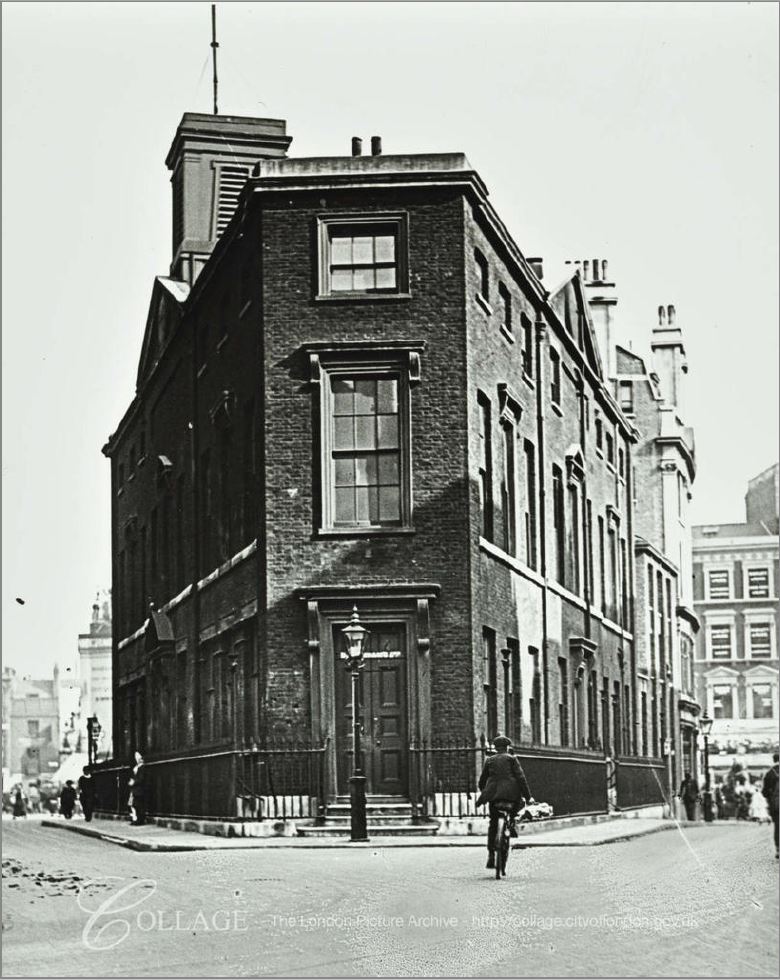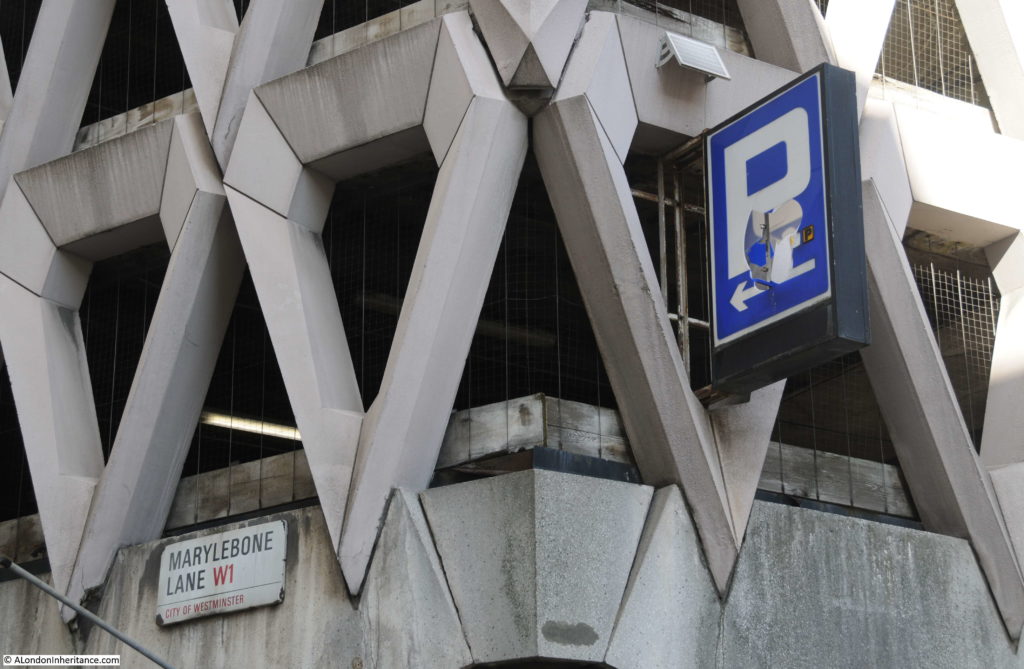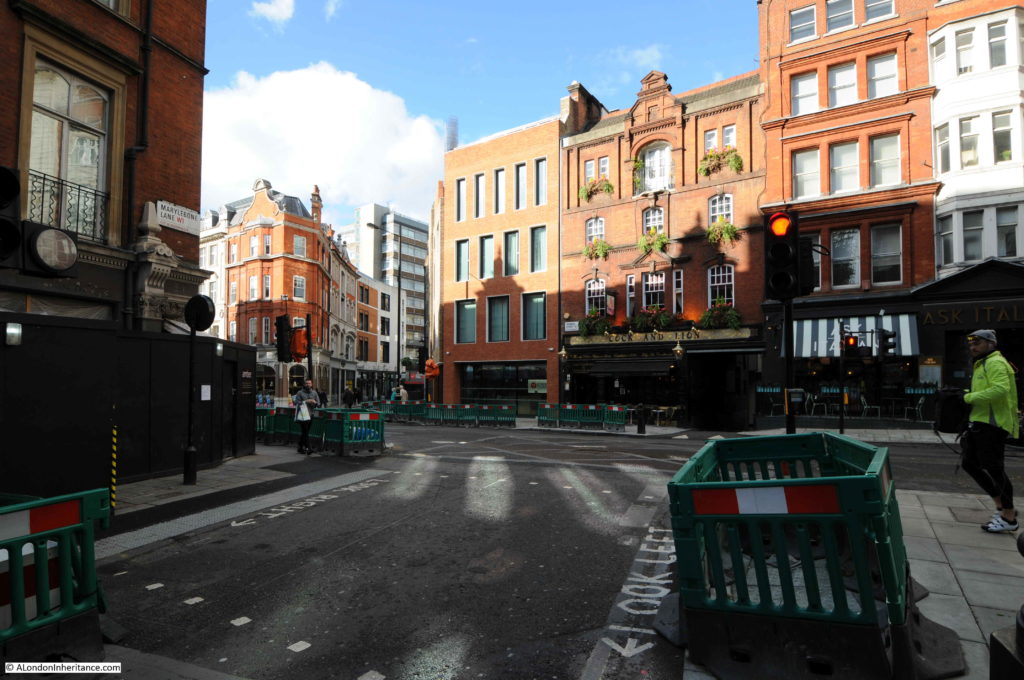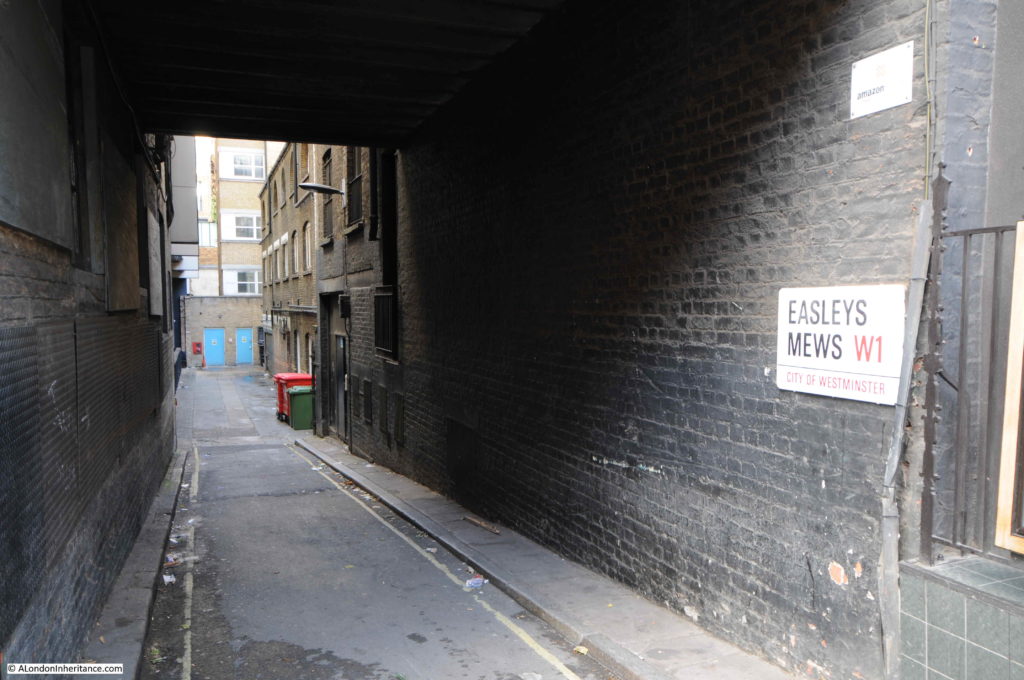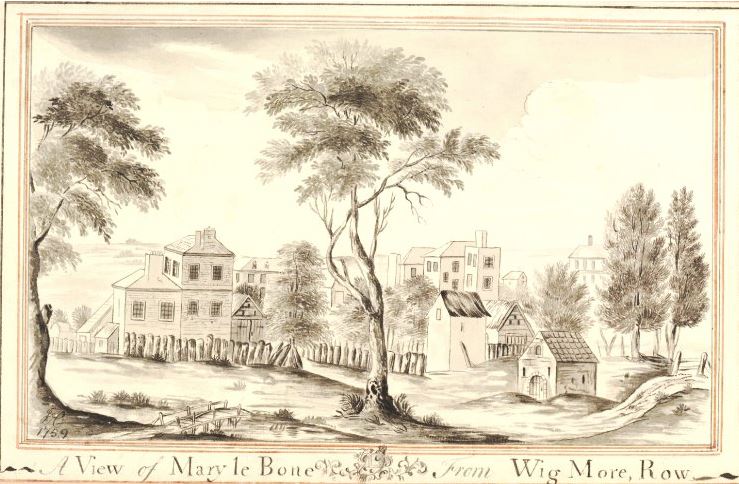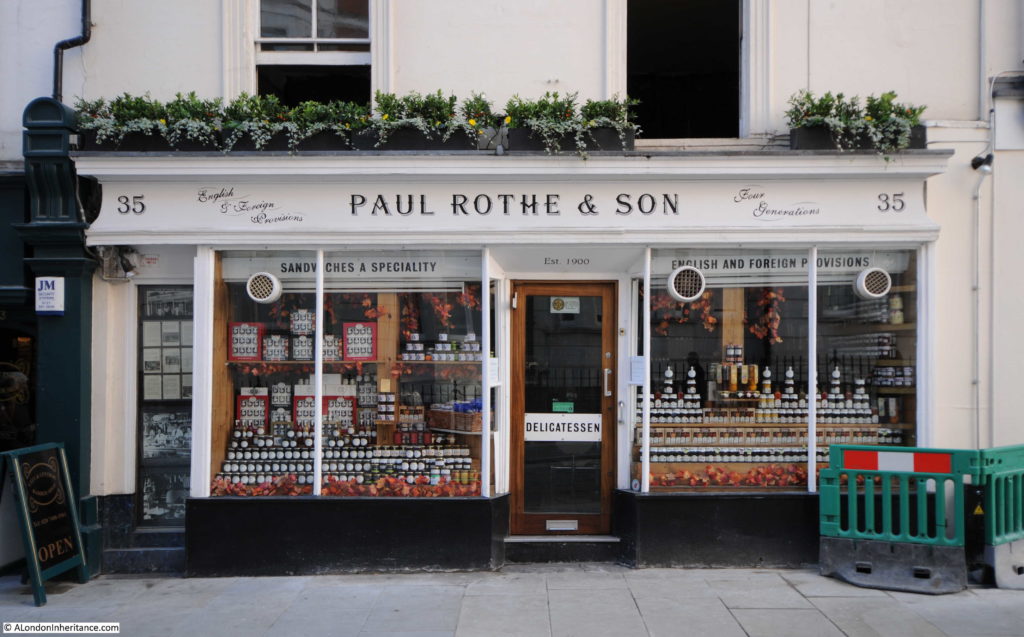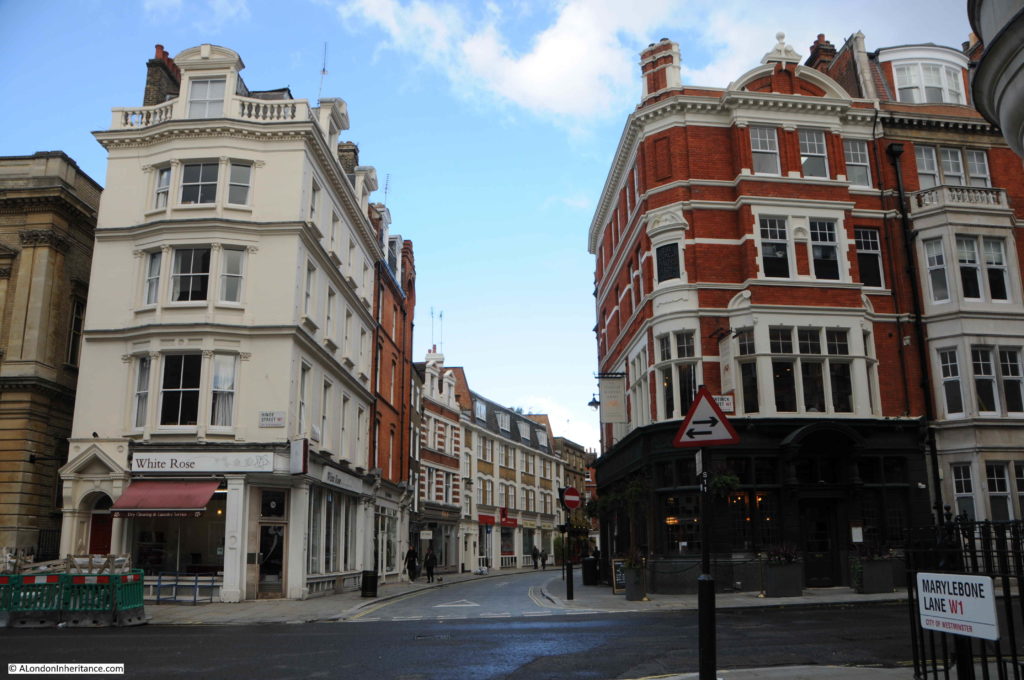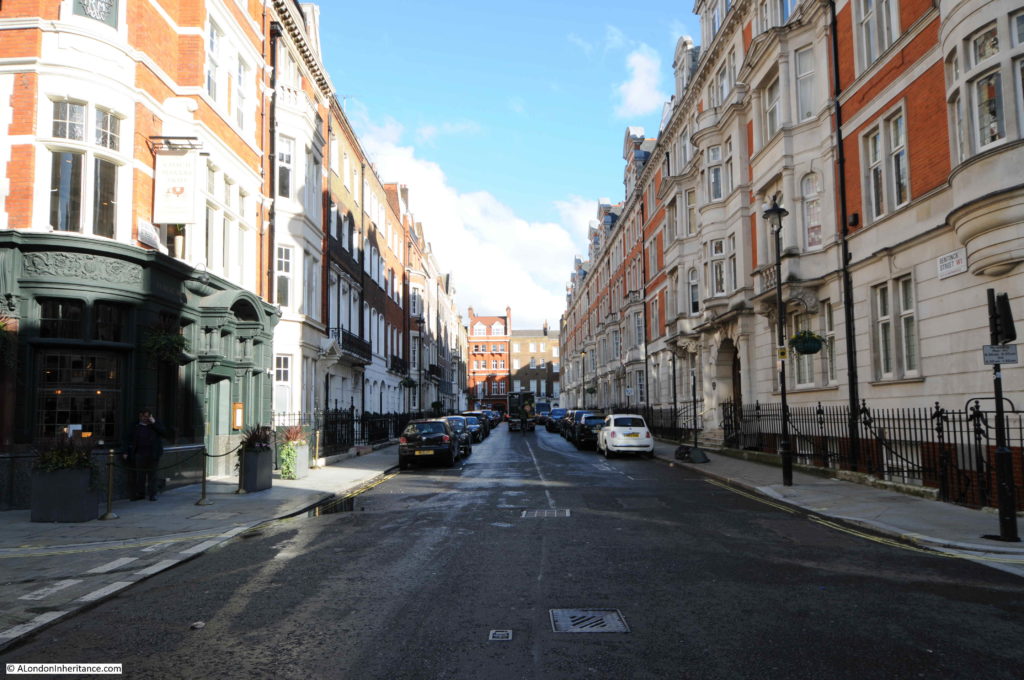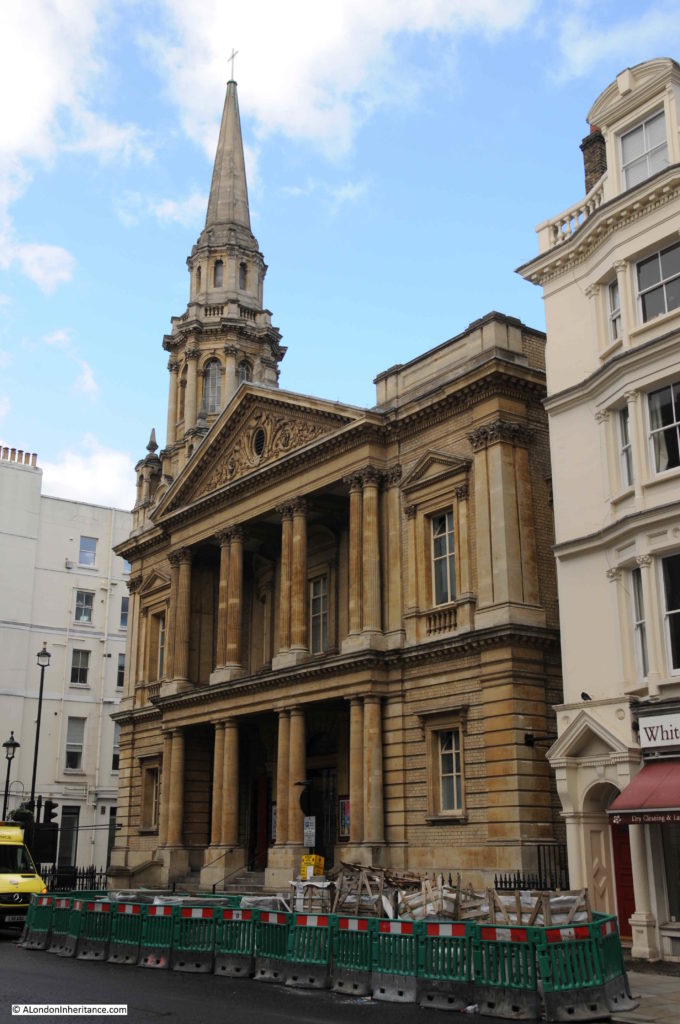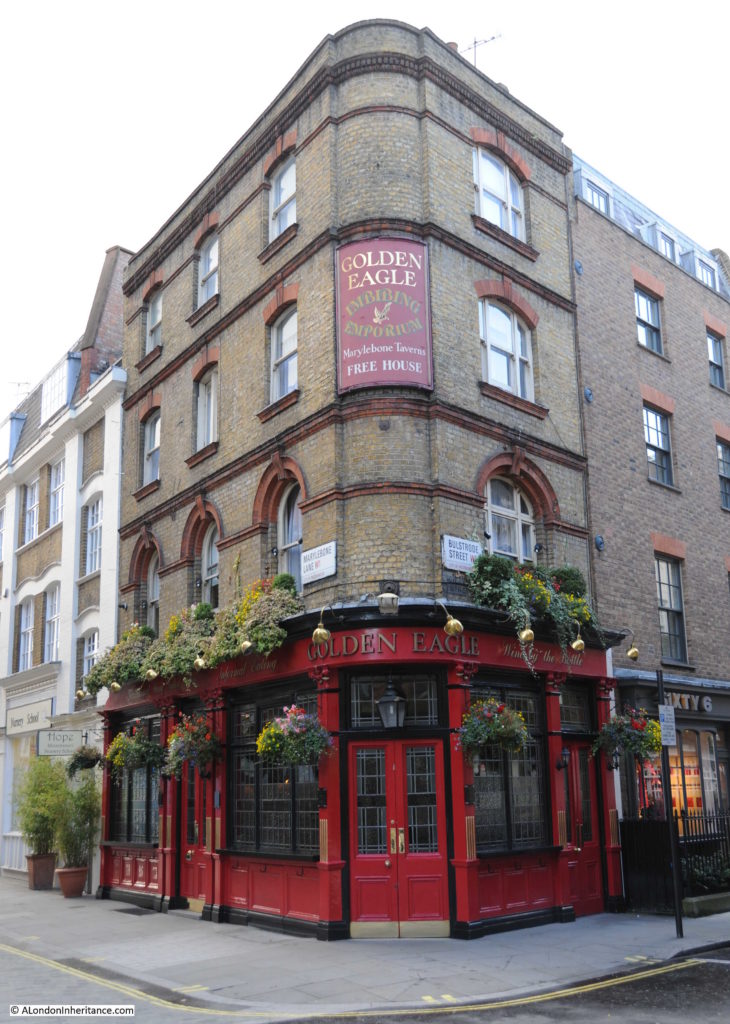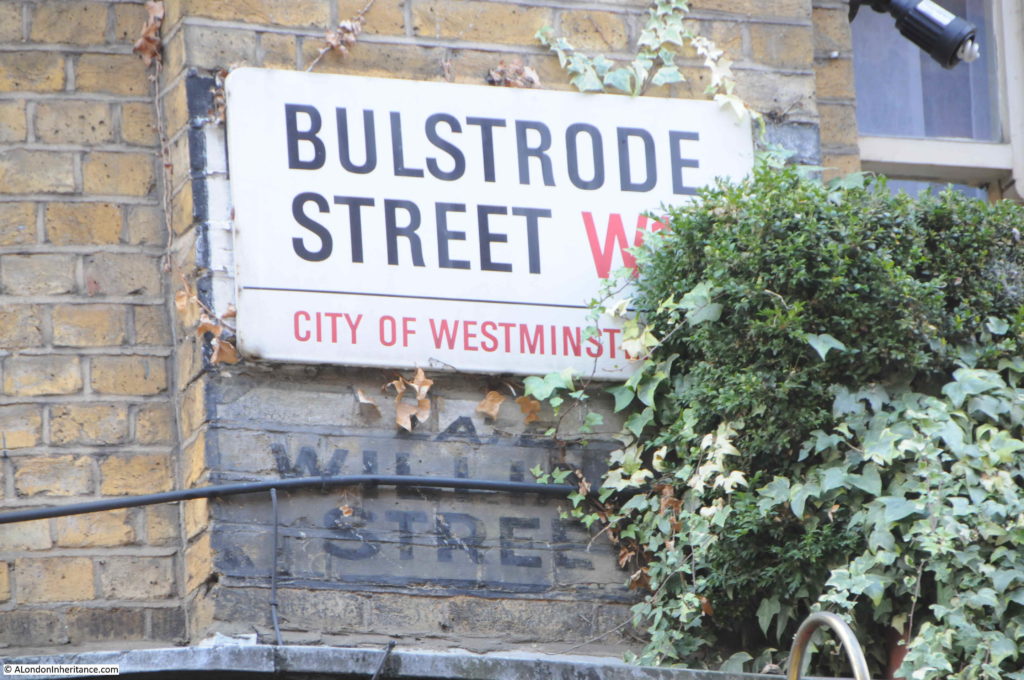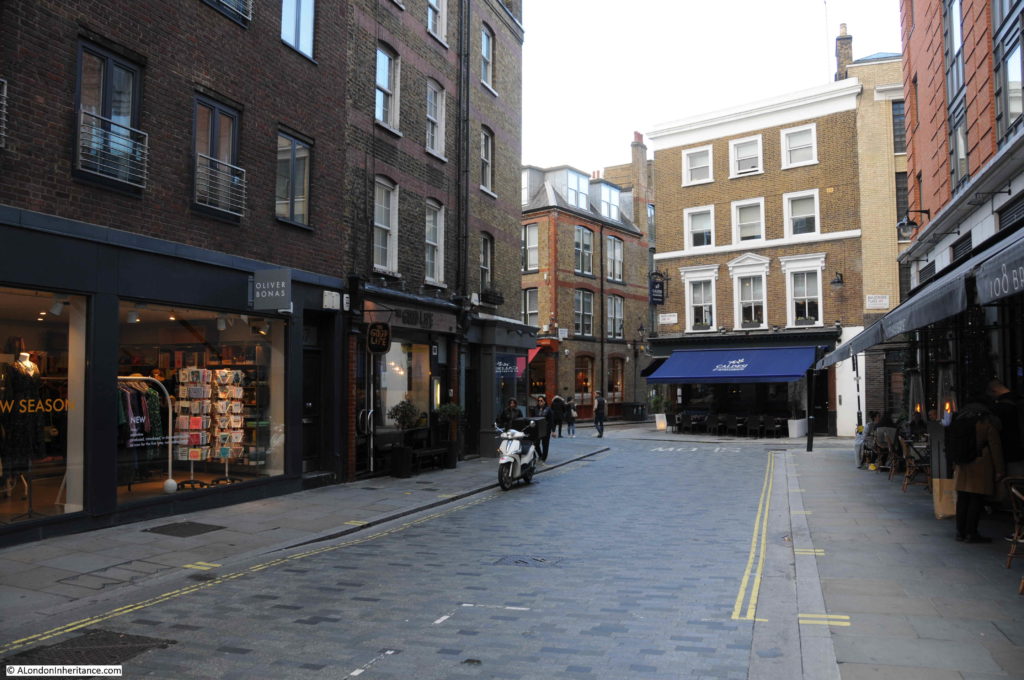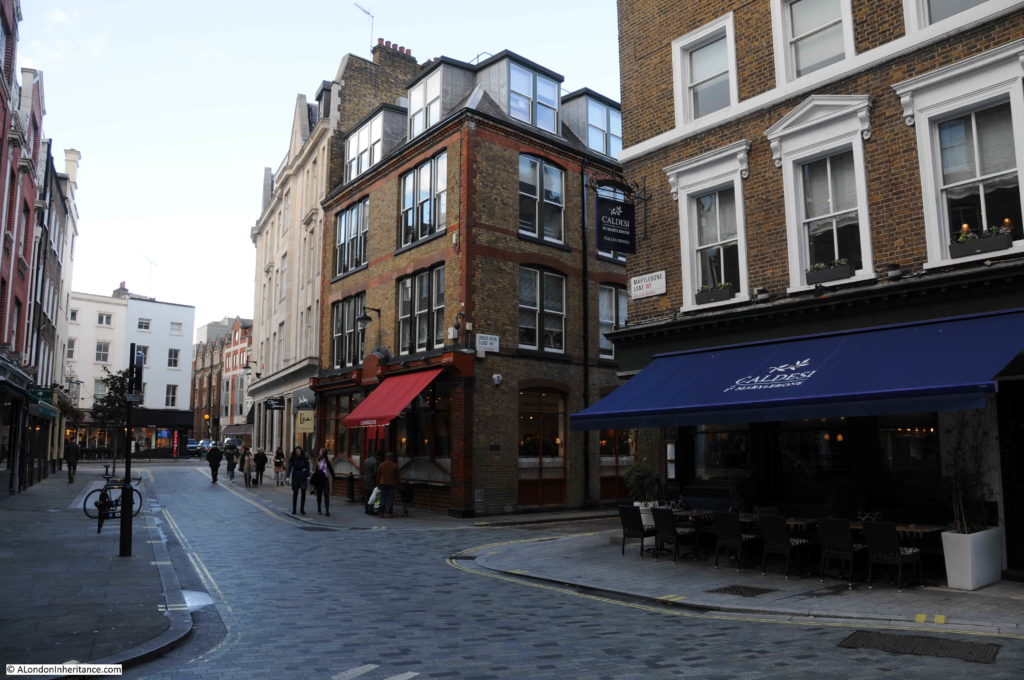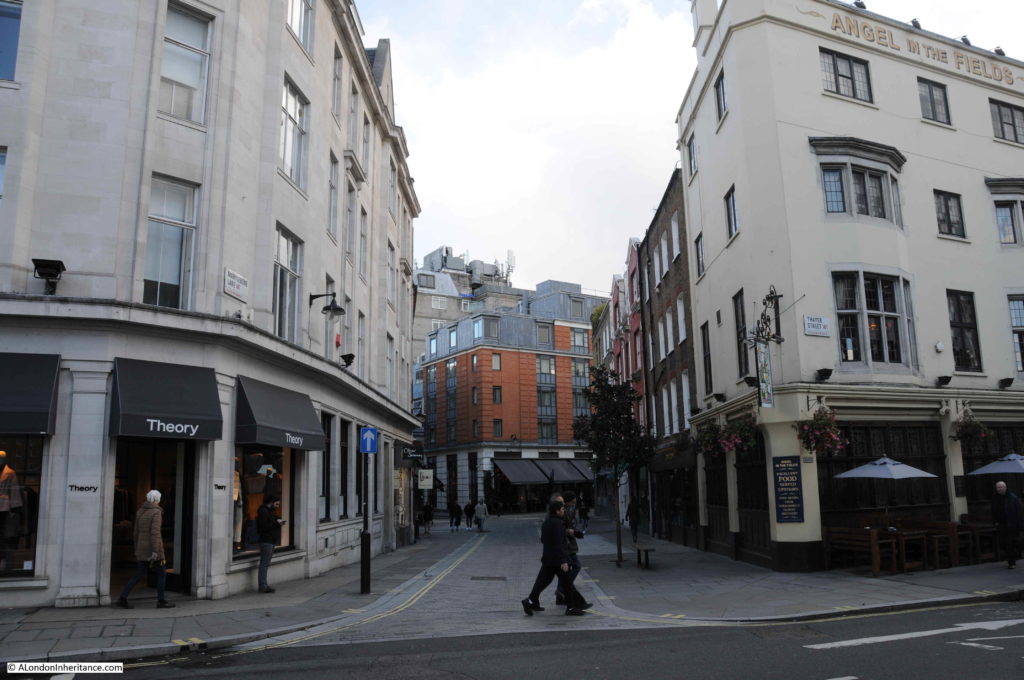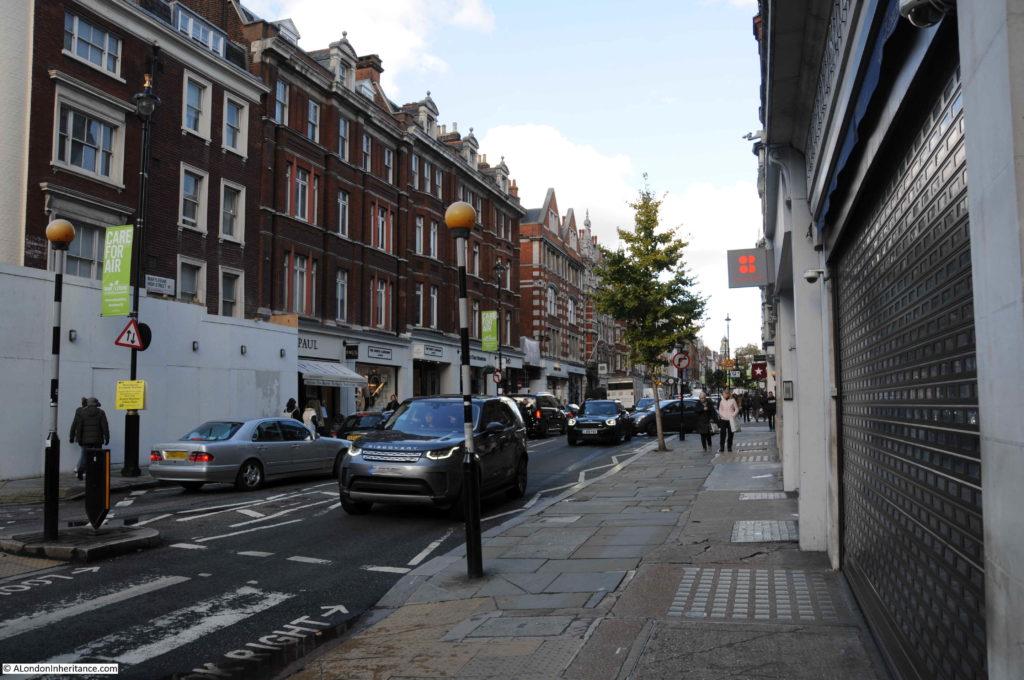London is so built up that it is hard to imagine that anything from the original rural environment remains. Major streets tend to follow much earlier alignments, and there is one street north of Oxford Street that still follows the same route from the time when the street ran through fields. This is Marylebone Lane.
In the following map extract, Oxford Street is the orange street running from the bottom left corner, across the map to the right. Just to the right of the middle of the stretch of Oxford Street shown below, there is a pair of streets, forming a triangle and branching northwards. This pair of streets then combine and continue northwards. The angled and curving shape of the street stands out from the grid pattern of the surrounding area.
Map © OpenStreetMap contributors.
Back in 1746, when John Rocque was mapping London, this area was on the edge of the built city. In the map extract below, the top of the triangular section can just been seen at the bottom of the map. Marylebone Lane then runs northwards with the same outline as can be seen today. The first evidence of the grid layout of streets that will soon cover the whole area can be seen in the lower right corner. Fields cover much of the rest of the map with the formal Marybone Gardens at the top of the map.
On an autumn afternoon, I went for a walk along Marylebone Lane, trying to imagine the fields, ponds and streams that once lined the lane, as well as discovering how Marylebone Lane acted as a boundary between the estates and developments that were springing up on either side of this old lane in the 18th century.
I also wanted to take some photos of Welbeck Street Car Park before what now looks like a certain demolition and replacement with a hotel building that will look similar to so many other hotels across London.
I turned off a very busy Oxford Street into the relative quiet of Marylebone Lane, passing the bulk of the Debenhams store, to the junction with Henrietta Place where I turned round to see the two branches of Marylebone Lane, with the triangular plat of land in the middle.
This plot of land and the split of Marylebone Lane can be seen in detail in the following extract from Rocque’s map.
Today, the road at the bottom is Oxford Street. In 1746, according to Rocque, the junction with Marylebone Lane appears to mark the junction where the name Oxford Street ends, and the name Tyburn Road takes over and continues up to Tyburn, roughly where Marble Arch is today. This change of names as streets cross Marylebone Lane will be a recurring theme.
Before the expansion of London built over these fields, Marylebone Lane ran from Tyburn Road, through the village of Marylebone to what were the northern parts of the parish, and ended within the current location of Regent’s Park.
In 1746 Marylebone Lane still ran the full length of this route, however building in the later half of the 18th century, including construction of Marylebone High Street, truncated Marylebone Lane to the southern portion of the route, so the section we can walk today is only part of the original full route.
The triangular plot of land, with the frontage onto Tyburn Road / Oxford Street has long been a significant location. Originally home to the parish church of Tyburn, then the first church of St. Marylebone, then being the location for a number of administrative functions for the parish, including a court and watch house. The book “London” by George H. Cunningham (1927) simply refers to this plot of land “Supposed to be the site of the ancient church of Tyburn, from a mass of skeletons that were dug up here in 1724”.
The watch house was photographed in 1920 and shows the same triangular layout with the two branches of Marylebone Lane leading down to Oxford Street.
Image credit: London Metropolitan Archives, City of London: catalogue ref: SC_PHL_01_316_79_7322
The first junction we come to is that with Henrietta Place, or Henrietta Street as it was in 1746. The map at the top shows that a short distance along Henreitta Place, there is a junction with Wellbeck Street, today the street name only has a single L.
It is between Marylebone Lane and Welbeck Street that we can find the Welbeck Street Car Park.
Proposals for post war planning of the city all generally accepted that there would be rapid growth in the numbers of cars that the city would have to accommodate. This led to some schemes that did get built, such as the Upper and Lower Thames Street through route, as well as many schemes that fortunately did not get built. I will write about some of these schemes in a future post. Actively accommodating the car continued through the closing decades of the 20th century and one result was the rather wonderful Welbeck Street Car Park.
The car park, designed by Michael Blampied and Partners for the adjacent Debenhams store was built between 1968 and 1970. It was a condition of approval for the Debenhams store that the car park was built as Westminister Council’s planning regulations required developments such as the store to have appropriate parking facilities.
Internally, it is a functional, multi-storey car park, but externally it has a remarkable design with prefabricated concrete diamonds covering all floors above the ground floor.
The car park is under threat of demolition after having been purchased by a developer with the intention of building a hotel on the site. Attempts have been made to get the building listed, or alternate uses which retain the exterior fabric of the building, but these appear to have been rejected and demolition awaits.
The building is stunning from a distance, but get up close and the repetition of the triangular concrete shapes creates some fascinating patterns. I wonder if it is just coincidence that the triangular shape mirrors the shape for the land opposite the car park, where Marylebone Lane reaches Oxford Street?
The car park from the junction of Henrietta Place and Welbeck Street.
Leaving the Welbeck Street car park, and continuing along Marylebone Lane, we come to the junction with Wigmore Street.
In 1746 this street was named Wigmore Row and came to an abrupt halt at the junction with Marylebone Lane as the land to the west was still field, and had yet to be developed.
The following photo is in Marylebone Lane, looking across Wigmore Street. On the left can be seen the curving, continuation of Marylebone Lane. The slightly offset continuation of the street is the same as shown in the 1746 map.
In 1746, the area directly opposite was field and just behind where the buildings now stand there appear to have been a couple of large ponds.
This is looking along Wigmore Street towards the west and shows the straight street approach of the grid layout in the area which helps Marylebone Lane stand out as being different, and older than the rest of the area.
Although the 18th century onward developments follow a grid pattern, there are still many, small side street, alleys and mews. These provide access to the central core of the buildings within the square of the grid. The pub directly opposite Marylebone Lane is the Cock and Lion and the entrance to Easleys Mews takes up part of the ground floor space of the pub.
In the 18th century, the area was very different. The following print from 1759 is titled “View of Marylebone from Wigmore Row”
One of the City Conduits that stood near Marylebone Lane is shown in the print. In the large field north of Wigmore Row in the 1746 map there is a small black dot labelled conduit.
Crossing over Wigmore Street, we continue along Marylebone Lane and the curved nature of the street is apparent.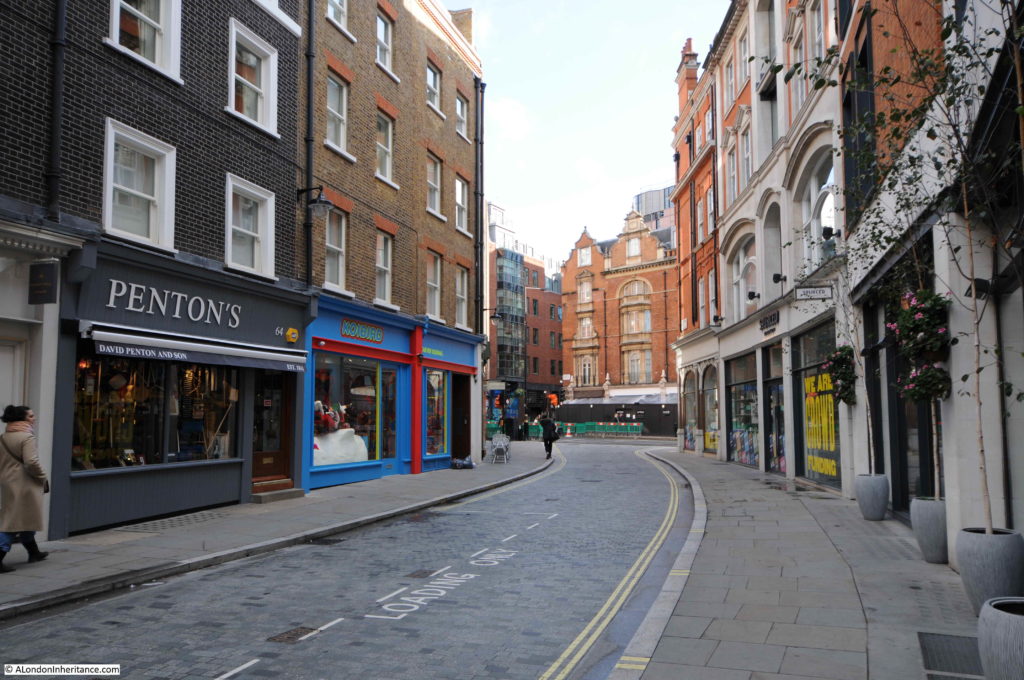
Marylebone Lane retains a number of one off shops, including the hardware store Penton’s which claims to be the oldest store on Marylebone Lane having been established in 1841.
At number 35 is Paul Rothe & Son. If you look to the left of the shop there are several pages of information which tell the fascinating story of the shop.
Paul Rothe was a German who worked his way to London in 1899 and opened a delicatessen on Marylebone Lane in 1900. The store has been in the same family ever since.
We now come to the junction with Bentinck Street, another of the wide streets that cut east – west across the old lane. The slightly curving Marylebone Lane can be seen directly across the street.
On the corner of Bentinck Street and Marylebone Lane is the Coach Makers Arms.
The current building dates from the early 1900s, however there has been a pub on the site since the 18th century. The pub has been through a couple of name changes (the O’Conor Don and the Conduit of Tybourne) but has returned to the original name for the pub.
Looking east along Bentinck Street, again showing the straight streets that make up the grid layout of this area of Marylebone.
Bentick Street ends at the junction with Marylebone Lane and continues on as Hinde Street. These name changes in otherwise straight streets shows how Marylebone Lane acted as a boundary as estates developed in the area with separate estates to the east and west of the lane.
As we cross over Bentinck Street / Hinde Street, the Hinde Street Methodist Church can be seen to the left.
The first Methodist Chapel was built on the site in 1810 and the current building dates from 1887.
Continuing along Marylebone Lane, the next junction is with Bulstrode Street and on the corner is another 19th century pub, the Golden Eagle, described on the corner sign as an “Imbibing Emporium”.
Unlike the Coach Makers Arms, the Golden Eagle retains the feel of a local London pub. Lacking the expensive refurbishment and decor, the pub is the perfect stop for a “local” drink and has a wonderful atmosphere.
The pub provides more evidence of how Marylebone Lane acted as a boundary as the area developed. Just below the Bulstrode Street sign, there is a painted sign on the brickwork stating that the name was “Late William Street”.
Although today, Bulstrode Street is the name of the full length of the street that cuts across Marylebone Lane, originally, Bulstrode Street was the name of the street up to the Marylebone Lane junction. From then on, the street continued as William Street.
It is fascinating to see how this ancient lane provided a boundary as the estates developed from the mid 18th century onward and these boundaries can still be seen, reflected in the street names we see today.
Opposite the Golden Eagle is the haberdashery shop of V V Rouleaux. brilliantly decorated to reflect the colour of the goods for sale inside the shop.
Crossing over Bulstrode Street takes us into the final section of what remains of Marylebone Lane. There is a new building on the north eastern corner of the junction which has an interesting stained glass art work that records another feature of the area.
A plaque alongside the window provides these details:
“Light in the Darkness 2000 by Julian Stocks. This stained glass window celebrates the River Tyburn that flows beneath Marylebone Lane….it takes the form of a lantern which, when illuminated will act as a beacon. During the 18th century the River Tyburn was an open stream that ran from the hills of Hampstead Hearth down to the River Thames. Marylebone Lane follows the banks of the river, the course of which has since been culverted, but still maintains a presence most noticeable in it’s serpentine form.”
The Tyburn is possibly one of the reasons for the route of Marylebone Lane, if the lane did follow the bank of the river. Nicholas Barton in his book “The Lost Rivers of London” (1960), provides the following background:
“Marylebone Lane was originally on the left bank of the stream, and its winding line indicates the course of this part of the steam”. The book includes a photo from 1957 showing a muddy stream at the bottom of some sewer excavations in Marylebone Lane. Whilst it would be hard to prove that this was the Tyburn, it does show that there is running water beneath the ground.
Continuing on from the junction with Bulstrode Street, we now reach the point in Rocque’s 1746 map where Marylebone Lane makes a sharp left turn at the junction with another street that runs in from the east. The same turn to the left can be seen today.
A road still joins from the east, although today this street (Bulstrode Place) is a short street terminated by buildings with no exit.
This is the view looking west at the turning point with the last short run of Marylebone Lane before it meets with Thayer Street, the street marked on the Rocque map as St. Mary Le Bone which ended here rather than continuing on down to Hinde Street, as Thayer Street does today.
At this corner, Cross Keys Close, one of the many little mews and dead end streets that lead from Marylebone Lane, can be found. Cross Keys Close was developed in the 1760s. These little side streets provide access to the centre of the blocks built within the grid pattern of streets.
The view from within Cross Keys Close, looking down Marylebone Lane.
And at the end of Marylebone Lane is Thayer Street. This is the view looking back into Marylebone Lane. On the right is the pub, Angel in the Fields.
This pub can be found on the 1746 map. Where Marylebone Lane turns left and meets the road marked as St. Mary Le Bone, at the junction there are a number of buildings. The lower right building within a small patch of land with trees edging the boundary, is the Angel pub. The pub was first recorded in 1720, and was rebuilt in 1770 as the area was being developed.
The “in the Fields” addition is from the refurbishment of the pub in 2001.
This is the view north from the junction with Thayer Street where it becomes Marylebone High Street. Another example of the straight streets that contrast with the narrow, winding nature of Marylebone Lane.
John Rocque’s map provides a glimpse of this part of London, when fields, streams and ponds still cover the land. The future for the area can be seen in the lower right of Rocque’s map as the grid of streets and buildings continues London’s northward expansion.
Walking Marylebone Lane is to walk a street that existed long before the buildings that now dominate the view. The street also acted as a boundary between the estates and developments on either side. evidence of which can still be seen in the way that the names change of the long, wide streets as they cross this narrow lane.
Having walked the lane, rather than return to the crowds of Oxford Street, the best option was to continue an almost 300 year tradition, and stop for a drink in the Angel.


